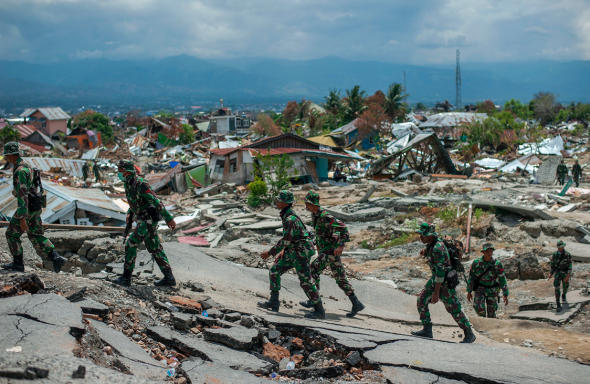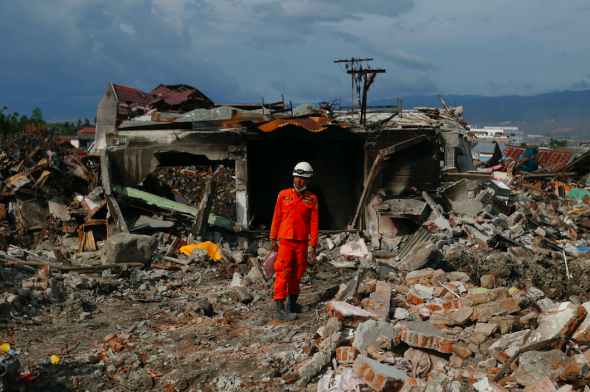Horror in Indonesia: Emergency responder calls earthquake and tsunami aftermath ‘one of the worst' he's ever seen
Following the devastating 7.5 magnitude earthquake and subsequent tsunami that rattled Indonesia in late September, the death toll has exceeded 2,000.
Search and rescue efforts came to an official end this week, despite aid organizations citing the need for ongoing support, particularly in Palu, a small Sulawesi Island city rocked hardest by the quake.

Indonesian soldiers walk at the earthquake-devastated neighborhood of Balaroa during the visit of U.N. Secretary General Antonio Guterres and Indonesian Vice President Jusuf Kalla in Palu, Central Sulawesi, Indonesia, Friday, Oct. 12, 2018. (AP Photo/Fauzy Chaniago)
Five thousand people remain missing, potentially buried under the mountain of rubble, the National Disaster Mitigation Agency estimates.
The decision to end search and rescue efforts was followed by an order from the Indonesian government for international aid groups to pull out of the region and return to their home countries.
The move was criticized by many, with United Nations figures suggesting around 200,000 people still need humanitarian support.
Emergency responder Vlatko Uzevski, MD, of Project HOPE has spoken out about the desperation in Palu:
"The suffering is palpable. The suffering of those who are leaving. The suffering of those who are staying. Mothers with children stand in long lines at the airport hoping and praying that they will be able to take the next flight out of the city. But even they are sad, suffering. They are leaving their homes, their loved ones - some who may be dead, some still missing," he said.

A rescuer from the National Search and Rescue Agency (BASARNAS) stands near a destroyed home at Balaroa neighborhood in Palu, Central Sulawesi, Indonesia, Thursday, Oct. 11, 2018. (AP Photo/Dita Alangkara)
"I've been to many disasters as an emergency responder, but this one is definitely one of the worst. And this is just Palu. I can't even imagine the situation in other cities."
NGO Save the Children's national partner in Indonesia, Yayasan Sayangi Tunas Cilik (YSTC) said it was "with a heavy heart" that they learned about the end the search and rescue mission.
The charity cited National Disaster Mitigation Agency figures, noting that 1,500 children could be among the missing.
"Children are particularly vulnerable in disasters, and to think that so many will never have the chance to grow up is heartbreaking," Selina Sumbung, Chairperson of YSTC said.
"These figures hide the individual suffering of each one of these families, who need to cope with the horror of not knowing whether their loved ones are alive. The anxiety they must be feeling, along with the daily concerns of finding food to eat or a dry place to sleep, is hard to comprehend."
Experts from charity World Vision have estimated it could be at least two years before communities in and around Palu recover fully from the disaster.
